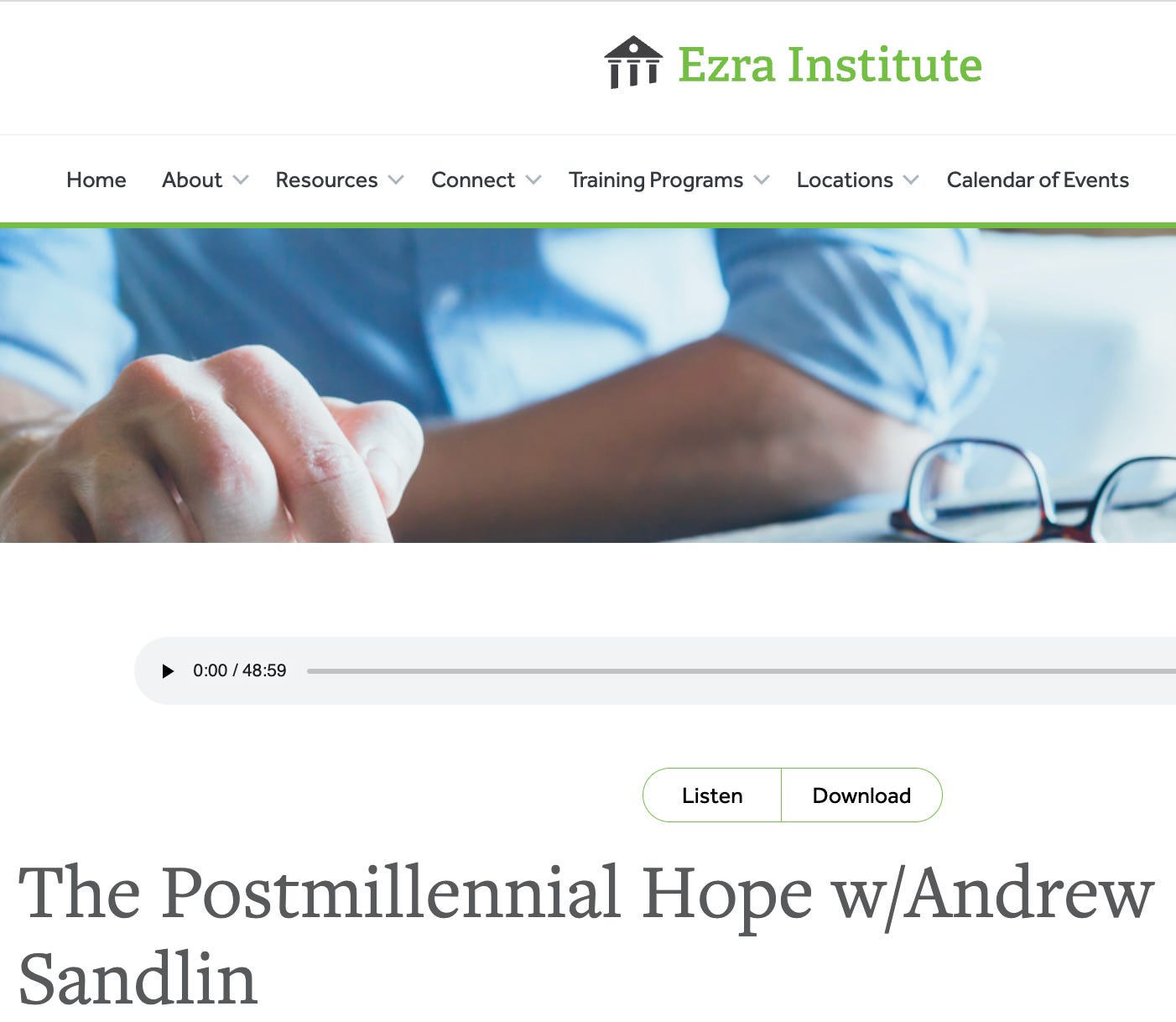Baptism and the Visibility Paradigm
Baptism is the single formal initiation into Christianity’s victorious visibility paradigm. If we care about kingdom victory, we must recover the robust kingdom idea of baptism.
Dear friends and supporters:
Few theological topics can generate debate as quickly as baptism, and the arguments for all sides of this debate, essentially unchanged for generations, will likely persist long into the future. Most notable are questions surrounding the meaning of baptism (is it an ordinance, sacrament?), the efficacy of baptism (covenantal? regenerative?), the subjects of baptism (who may get baptized? Christians’ infants, or professing adults?), and the mode of baptism (is it sprinkling, pouring, immersion?) My own views on these issues are confident and settled, and I try never to make them a bone of contention with other orthodox, Bible-believing Christians.
My increasing concern is with cultural theology, that is, theology as it interfaces with culture, both the influence of theology on culture, and the influence of culture on theology. I am particularly interested in how theology shapes worldview, and worldview shapes theology. These days, my interest in baptism is therefore a worldview interest, and less an ecclesial interest, while fully recognizing baptism’s inescapably churchly character.
The Visibility of Baptism
Take, for example, the visibility of baptism. Whatever metaphorical usages baptism might denote (“Spirit baptism,” or baptism by fire), they derive their significance from the administration of a very visible, literal act in or by ordinary water. The basic referent of baptism in the Bible is water baptism, and it’s inherently visible.
I usually make this point when preaching about Romans 6, which I consider the most important chapter in the Bible on the Christian life. It teaches that living as a Christian is possible only in vital union with the crucified and risen Lord Jesus Christ. Paul makes clear that the visible instrument of this union is baptism (v. 3).
I ask the congregation to lift their hand if they have a baptismal certificate. Most hands go up. I then ask how many have a born-again certificate. No hand is ever raised. I point out to them that there’s a very good reason for this differing response, and it’s not because baptism is more important than regeneration. Rather, baptism can be memorialized with a visible certificate because baptism, unlike regeneration, is a visible, tactile, dateable act. You probably don’t know precisely when you were regenerated (even if you think you do), but you can know for certain when you were baptized, because people were there to record it, even if as an infant or child you can’t remember it.
For Paul, baptism marks union with Christ, because it is the visible transition from wrath to grace, from being in Adam to being in the Second Adam, from a life of unrighteousness to a life of righteousness. While regeneration is an internal transformation, baptism is an external transition, and the latter is just as important as the former. Whenever we might’ve been regenerated (born again, or anew), for Paul it is the visible union with Christ in baptism that marks the decisive visible life transition.
This way of thinking is foreign to many Christians because they equate the deepest spirituality with invisibility. Why? The Christian Faith is chiefly about what goes on inside them, invisibly, and what goes on outside in the external world is secondary and tangential. God is an unseen spirit; therefore, the invisible is inherently superior to the visible. But they might consider that God is less invisible than they sometimes suppose (Ex. 33:23; Col. 1:15a), and that both the invisible and visible aspects of created reality stand under Christ’s Lordship (Col. 1:15–16), not one more important than the other.
The Invisibility Paradigm
This invisibility preference is not particularly new. The first heresy of the church was Gnosticism, which saw the visible, created order as inferior to the “spiritual” (usually, and wrongly, defined as non-physical), internal, and invisible. Most of the sects and heretics in Christian history (Paulicians, Bogomils, Cathars, Anabaptists) were committed to an invisibility paradigm, precisely because they recognized the sins and errors, sometimes numerous, of the visible church of the time. The most important Christianity goes on where nobody can see it, not out in the visible church and world.
Yet the solution to a misguided and apostate visible church is not to elevate a so-called “invisible” church, but to reform the visible church, that is, the legitimate church. It’s true that, as the Protestant reformers recognized, there’s an invisible dimension to the church, that is, true believers as a subset of the entire visible church, but that doesn’t mean there’s such a thing as an invisible church that exists or operates as a church body. The church, like Jesus himself, is a visible, tactile, pinchable reality.
This invisibility paradigm always marginalizes, and in some cases, has eliminated baptism. In fact, in the invisibility paradigm it’s not clear why baptism is necessary at all, or perhaps, only as a voluntary declaration of faith. But the Bible simply won’t sustain this mild, diffident significance of baptism (see Ac. 2:38; 22:16; Col. 2:12; 1 Pet. 3:21). Though baptism isn’t strictly essential to eternal life (recall the penitent thief crucified at our Lord’s side), there can be no Christian life without baptism.
I'm sometimes asked the best place in the Bible to start for proving postmillennialism. I reply, “Genesis 1:1.” An optimistic eschatology rests in an optimistic protology. The sovereign Creator fashioned a very good creation that will fulfill his kingdom-expanding dominion purposes in time and history.
This primer shows what an optimistic eschatology looks like.
Get hard copy and e-books here. Contact me privately (sandlin[at]saber[dot]net) for quantity pricing (10+ copies).
Ecclesial Baptism
Baptism lays out starkly the visibility of the Christian worldview. Baptism is widely (and correctly) understood as a church rite or ceremony, a sacrament or ordinance. In fact, as I noted above, baptism visibly unites us to Christ, but it does this by visibly uniting us to the church (1 Cor. 12:13). The church is the body of Christ (Eph. 5:23; Col. 1:18). Though this is a metaphor, not a literality, the church is the visible representation of Christ on earth. The visible baptismal act enrolls us in the visible church (recall that there’s no other kind).
But this is not baptism’s only, and probably not even its central, Christian sphere. Consider only one of the most vital biblical texts on baptism, the so-called Great Commission of Matthew 28:18–20. Here Jesus instructs his disciples in administering the first trinitarian baptism mentioned in the Bible:
And Jesus came and spoke to them, saying, “All authority has been given to Me in heaven and on earth. Go therefore and make disciples of all the nations, baptizing them in the name of the Father and of the Son and of the Holy Spirit teaching them to observe all things that I have commanded you; and lo, I am with you always, even to the end of the age.” Amen.
“[M]ake disciples of all the nations” doesn’t mean “make disciples from among all the nations [= be good 19th century pietistic evangelical missionaries] but rather, as our Lord states plainly, “make disciples of all the nations,” [= make all the nations disciples].
We often fail to notice that our Lord’s memorable mention of baptism pertains much less to the church (at least when we limit the meaning of “church”), and more obviously to the kingdom of God, which discipling the nations brings immediately to mind. The kingdom of God is the reign of God, and it’s extended principally by means of what we call the Great Commission, whose goal is the reign of God over the nations of the world.
Similarly, in Romans 4:17–18 Paul reminds his readers that God promised Abraham, the father of all the faithful (not just of believing Jews), that he would be father of many nations. Evangelizing and Christianizing the nations (these two acts amount to much the same thing) is the “great commission” charged to all disciples.
This global scope recalls Jesus’ message of the kingdom that must go to, envelop, and eventually overwhelm the world (Lk. 13:18–21), not just the church. Baptism is a visible means of discipling the nations, subordinating them to Jesus Christ by the authority of the gospel. In other words, baptism is the initiatory, visible step in expanding Christ’s kingdom.
You are regenerated sovereignly by the Holy Spirit (Jn. 3:5–8), but you are transitioned from the power of darkness into the kingdom of God’s dear Son (Col. 1:13) visibly at baptism. It shouldn’t surprise us that there are no recorded NT baptisms in liturgical or other corporate worship, though almost all instances of communion are. Baptism is a one-time act that puts you into the visible kingdom, and consequently into the church, while the Lord’s Table is a continuing ecclesial ceremony that sustains you in that church. Jesus’ final baptismal charge to his disciples and, therefore, us is primarily a kingdom charge.
How Baptism Became Radically Ecclesiasticized
But gradually with the collapse of the Roman Empire, the church created an alternative institutional structure, complete with centralized power, bureaucracies, rites of passage, and ceremonies (see Michael Kelley’s The Impulse of Power for the larger story). Baptism was reduced to its cultic-liturgical significance,1 as the church itself was. The kingdom-burgeoning role of new covenant baptism was relegated to the background to make way for the priority of the insular, bureaucratic church.
But in the Bible, the church (ecclesia) is the called-out-by-God people not just in its Lord’s Day resurrection celebration (which is indispensable), but also in its day-by-day kingdom work of world conquest by the gospel. Just as the old covenant church (Israel) wasn’t less the church when it subdued Canaan while simultaneously attending to its tabernacle worship, so the new covenant church is just as much the church when it battles for kingdom victory in culture while concurrently worshiping every Sunday. One is not less “church life” than the other. Baptism is the initial visible discipling act of kingdom advancement, not only church enrollment.
The first Jerusalem Christians were expelled from their local comfort zone by persecution; and they fanned outward, gospeling, baptizing, teaching — in other words, discipling the nations. Paul, Barnabas, Luke and their itinerant company were not first of all church planters; they were nation-disciplers whose work inevitably resulted in church plants. For all his palpable love for the church, Paul was not a vocational church planter. He was a kingdom-extender that as a result planted churches.2 Churches are one necessary consequence of kingdom conquest, and baptism is the initial visible act of that conquest.
Conclusion
Since the break-up of Christendom in the mid-17th century (the European Wars of Religion) and the subsequent “inward turn” of Pietism, Romanticism, and a renewed dualism, the invisibility paradigm has gradually strangled Protestant Christianity. “Heart religion” has been the priority. In Stephen Perks’ words, this has turned piety into a “private devotional hobby” in the shift away from the dominion commission (Ge. 1:28–30), the full-fledged stewardship of the visible world for God’s glory. Christians have surrendered the world to the Devil and his human minions. They’ve left science to naturalistic Darwinists. They’ve abandoned cinema to Hollywoodian homosexualization. They’ve outsourced education to the secular thugs at the NEA. All while the church revels in self-help therapy and “higher” spirituality that considers culture too “worldly” for Christian engagement. Incrementally the depravity of the culture becomes blindingly visible while the true Faith becomes mirky and invisible, sequestered from almost all the places we can see.
And this retreat often starts right at the inception of the Christian life with a truncated view of baptism, whose only visibility is the act itself. Its significance is instantaneously tapered to a narrowly ecclesial sphere, when in fact it is first a kingdom act, the single formal initiation into Christianity’s victorious visibility paradigm. If we care about kingdom victory, we must recover the robust kingdom idea of baptism.
Let’s make baptism visible again.
Will you consider a tax-deductible donation to CCL via PayPal or Venmo? Or mail a check to CCL, Box 100, Coulterville, CA 95311. God uses you to keep us going — and expanding.
Personal
Sharon and I were so blessed that our oldest son Richard visited us for his 40th birthday. He wanted for posterity a multigenerational photo of Sandlin Gospel preachers: Richard D., P. Andrew, and Richard A.
Saturday, July 29 in Charlotte, North Carolina
I’ll be speaking three times at the Christian Worldview Conference in Charlotte on Saturday, July 29. Here are the details.
Charlotte Marriott South Park
2200 Rexford Rd.
Charlotte, North Carolina
9:30 – Welcome and Opening Remarks
10:00 – “Classical and Cultural Marxism” – Sandlin
11:00 – “The Biblical Case for Christian Victory” – Sandlin
12:00 - 1:00 – Lunch
1:00 – “What Is All of This About Equity?” – Larry Ball
2:00 – “God’s Will for Your Life – You Can’t Improve on Creation” – Sandlin
3:00 – Q & A
For more information contact Rev. Larry Ball: larryeball1947[at]gmail[dot]com.
Yours for the King,
Founder & President, Center for Cultural Leadership
What is a postmillennialism and what are its alternatives? What are the chief distinctives of postmillennialism? How has the church failed to be optimistic? What are the roots of Christian pessimism?
Listen here.
More great stuff:
The Center for Cultural Leadership site is here.
My Amazon author page (print and digital) is here.
My I-Tunes sermons, lectures and podcasts are here.
You can find my sermons and lectures at my YouTube channel.
Sign up to get my blog updates here.
Here’s my Twitter feed.
If you want to get the free exclusive hard copy publication Christian Culture, please send me a Facebook private message.
The CCL phone number is 831-420-7230.
The mailing address is:
Center for Cultural Leadership
P. O. Box 100
Coulterville, CA 95311
Hendrik Hart, “The Institutional Church in Biblical Perspective,” International Reformed Bulletin, 49/50 [1972], 10–21.
On an explanation of this idea, see Stephen C. Perks, Disciple the Nations (Taunton, England: Kuyper Foundation, 2022), 71–79.








